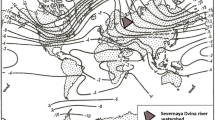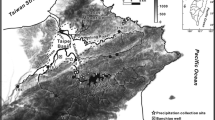Abstract
The ability to detect hydrologic variation in large arctic river systems is of major importance in understanding and predicting effects of climate change in high-latitude environments. Monitoring uranium isotopes (234U and 238U) in river water of the Yukon River Basin of Alaska and northwestern Canada (2001–2005) has enhanced the ability to identify water sources to rivers, as well as detect flow changes that have occurred over the 5-year study. Uranium isotopic data for the Yukon River and major tributaries (the Porcupine and Tanana rivers) identify several sources that contribute to river flow, including: deep groundwater, seasonally frozen river-valley alluvium groundwater, and high-elevation glacial melt water. The main-stem Yukon River exhibits patterns of uranium isotopic variation at several locations that reflect input from ice melt and shallow groundwater in the spring, as well as a multi-year pattern of increased variability in timing and relative amount of water supplied from higher elevations within the basin. Results of this study demonstrate both the utility of uranium isotopes in revealing sources of water in large river systems and of incorporating uranium isotope analysis in long-term monitoring of arctic river systems that attempt to assess the effects of climate change.
Resume
La capacité à détecter des variations hydrologiques au sein de grands hydrosystèmes arctiques est essentielle pour la compréhension et la prédiction des effets du changement climatique dans les régions de haute latitude. Le suivi des isotopes de l’uranium (234U et 238U) dans l’eau des cours d’eau du bassin versant du Yukon en Alaska et au Nord-Ouest du Canada pour la période 2001–2005 a permis d’accroître la capacité à identifier l’origine des eaux des cours d’eau ainsi que les modifications de flux qui se sont produites au cours des cinq ans de la période d’étude. Les données isotopiques de l’Uranium pour la rivière du Yukon et de ses principaux affluents (Porcupine et Tanana) permettent d’identifier plusieurs sources qui contribuent aux écoulements, incluant : eaux souterraines profondes, eaux souterraines des alluvions dont les cours d’eau sont gelés de manière saisonnière et l’eau de la fonte des glaciers en haute altitude. Le tronçon principal de la rivière du Yukon montre des modalités de variation isotopique en uranium au niveau de plusieurs sites, reflétant des apports de fonte de glace et d’eaux phréatiques au printemps, ainsi que des variabilités pluriannuelles augmentant avec le temps mais aussi en termes de quantité d’eau provenant des zones les plus élevées du bassin versant. Les résultats de cette étude démontrent l’utilité des isotopes de l’uranium pour révéler l’origine des eaux au sein d’un grand hydrosystème et de leur intégration pour le suivi sur le long terme des systèmes hydrologiques arctiques afin d’essayer d’évaluer les effets du changement climatique.
Resumen
La habilidad para detectar variaciones hidrológicas en grandes sistemas de ríos árticos es de fundamental importancia para el entendimiento y la predicción de los efectos del cambio climático en ambientes de altas latitudes. El monitoreo de los isótopos de uranio (234U y 238U) en el agua de ríos de la cuenca del río Yukón de Alaska y noroeste de Canadá (2001–2005) ha mejorado la habilidad para identificar las fuentes de agua que alimentan los ríos, así como para detectar cambios de flujo que hayan ocurrido en los cinco años de estudio. Los datos de isótopos de uranio para el Río Yukón y los principales tributarios (los ríos Porcupine y Tanana) identifican varias fuentes que contribuyen al flujo del río, incluyendo agua subterránea profunda, agua subterránea proveniente de agua estacionalmente congelados en ríos de valles aluviales, y agua de derretimiento de glaciares de altas elevaciones. El curso principal del Río Yukón exhibe esquemas de variaciones de isótopos de uranio en varias localidades que reflejan la entrada de agua partir del derretimiento de hielo y del agua subterránea somera en los manantiales, así como un esquema multianual de variabilidad incrementada en el tiempo y en la cantidad relativa de agua proveniente de las más altas elevaciones dentro de la cuenca. Los resultados de este estudio demuestran tanto la utilidad de los isótopos de uranio para las fuentes de agua relevadas en los grandes sistemas de ríos, como la incorporación del análisis de isótopos del uranio en el monitoreo a largo plazo de sistemas de los ríos árticos que intentan evaluar los efectos del cambio climático.
摘要
在大规模北极河流系统中监测水文变化的能力对于了解及预测高纬度环境下气候变化的作用很重要。基于对阿拉斯加州及加拿大西北部Yukon流域河水(2001–2005)中铀同位素(234U/238U)五年的监测增强了识别河水来源以及监测流场变化的能力。Yukon河及主要支流(Porcupine和 Tanana 河)的铀同位素数据识别出若干个流向河水的水源,包括:深层地下水、季节性结冰河水-山谷冲积地下水以及高地冰川融水。在Yukon河主干的不同位置显示出多种铀同位素变化模式,表现在来自春天冰融化及浅层地下水的补给,以及时间上多年变化模式和从盆地内较高位置补给水的相对份额。研究结果表明利用铀同位素可揭露大规模河流系统的水源,且结合北极河流系统长期观测中的铀同位素分析可尝试进行气候变化效应评价。
Resumo
A variação hidrológica em grandes sistemas fluviais do Ártico é de grande importância para compreender e prever os efeitos das alterações climáticas em ambientes de latitude elevada. A monitorização dos isótopos de urânio (234U/238U) na água da Bacia do Rio Yukon, no Alasca e no noroeste do Canadá (2001–2005), aumentou a capacidade de identificar as fontes de água que alimentam os rios, bem como a possibilidade de detetar alterações de fluxo que têm ocorrido neste período de cinco anos. Os dados de isótopos de urânio do Rio Yukon e dos seus principais afluentes (os Rios Porcupine e Tanana) permitem identificar as diversas fontes que contribuem para o fluxo do rio, incluindo: águas subterrâneas profundas, as que provêm da água subterrânea sazonalmente congelada dos aluviões do rio e águas que provêm do degelo dos glaciares a elevada altitude. O rio principal, oYukon, apresenta padrões de variação isotópica de urânio em diversos locais que refletem a entrada de águas subterrâneas de aquíferos subsuperficiais e do degelo na Primavera, assim como um padrão multianual de variabilidade crescente no tempo e da quantidade relativa de água que provém das partes mais altas da bacia. Os resultados deste estudo demonstram tanto a utilidade de isótopos de urânio em revelar as fontes de água em grandes sistemas fluviais, como a importância da análise de isótopos de urânio incorporando monitorização, a longo prazo, de sistemas fluviais do Ártico, para avaliação dos efeitos das alterações climáticas.










Similar content being viewed by others
References
Anderson GS (1970) Hydrologic reconnaissance of the Tanana River basin, central Alaska. US Geol Surv Hydrol Investigat Atals HA-319, 4 plates
Bagard ML, Chabaux F, Pokrovsky OS, Prokushkin AS, Viers J, Dupre B (2008) Temporal variations of chemical weathering fluxes in boreal rivers under permafrost conditions: examples of the Nizhnaya Tunguska watershed (Central Siberia). EGU General Assembly 2008, EGU, Washinton, DC. Geophys Res Abst 10:EGU2008-A-04760
BESIS (Bering Sea Impacts Study) (1997) The impacts of global climate change in the Bering Sea region: Girdwood, Alaska, September 18–21, 1996, The BESIS project, University of Alaska, Fairbanks, AK
Brabets TP, Schuster PF (2008) Transport of water, carbon, and sediment through the Yukon River basin. US Geol Surv Fact Sheet 2008-3005
Brabets TP, Walvoord MA (2009) Trends in streamflow in the Yukon River basin from 1944 to 2005 and the influence of the Pacific Decadal Oscillation. J Hydrol 371:108–119
Brabets TP, Wang B, Meade RH (2000) Environmental and Hydrologic Overview of the Yukon River Basin, Alaska and Canada. US Geol Surv Tech Water Resour Invest Rep 99-4204
Chabaux F, Riotte J, Dequincey O (2003) U-Th-Ra fractionation during weathering and river transport. Rev Mineral Geochem 52:533–576. doi:10.2113/0520533
DePaolo DJ, Maher K, Christensen JN, McManus J (2006) Sediment transport time measured with U-series isotopes: results from ODP North Atlantic drift site 984. Earth Planet Sci Lett 248:394–410
Dornblaser MM, Halm DR (2006) Water and sediment quality of the Yukon River and its tributaries, from Eagle to St. Marys, Alaska, 2002-2003. US Geol Surv Open-File Rep 2006-1228
Dornblaser MM, Striegl RG (2007) Nutrient (N, P) loads and yields at multiple scales and subbasin types in the Yukon River basin, Alaska. J Geophys Res 112:G04S57. doi:10.1029/2006JG000366
Dosetto N, Turner S, Douglas GB (2006) Uranium-series isotopes in colloids and sediments: time scale for sediment production and transport in the Murray-Darling river system. Earth Planet Sci Lett 246:418–431
Halm DR, Dornblaser MM (2007) Water and sediment quality in the Yukon River and its tributaries between Atlin, British Columbia, Canada, and Eagle, Alaska, USA, 2004. US Geol Surv Open-File Rep 2007-1197
Hartmann B, Wendler G (2005) The significance of the 1976 Pacific Climate Shift in the climatology of Alaska. J Climate Res 18:4824–4839
Kigoshi K (1971) Alpha-recoil 234Th: dissolution into water and the 234U/238U disequilibrium in nature. Science 173:47–48
Kraemer T, Doughten M, Bullen T (2002) Use of ICP/MS with ultrasonic nebulizer for routine determination of uranium activity ratios in natural water. Environ Sci Tech 36:4899–4904
Osmond JK, Cowart JB (1976) The theory and uses of natural uranium isotopic variations in hydrology. Atomic Energ Rev 14:621–679
Osterkamp T, Romanovsky V (1999) Evidence for warming and thawing of discontinuous permafrost in Alaska. Permafr Periglac Process 10:17–37
Porcelli D, Swarzenski PW (2003) The behavior of U- and Th-series nuclides in groundwater. In: Bourdon B, Henderson GM, Lundstrom CC, Turner SP (eds) Uranium-series geochemistry. WMineralogical Society of America, Washington, DC
Riotte J, Chabaux F (1999) 234U/238U) activity ratios in freshwater as tracers of hydrological processes: The Strenbach Watershed (Vosages, France). Geochim Cosmochim Acta 63:1263–1275
Robinson L, Henderson G, Hall L, Matthews I (2004) Climatic control of riverine and seawater uranium-isotope ratios. Science 305:851–854
Schuster PF (2003) Water and sediment quality in the Yukon River Basin, Alaska, during water year 2001. US Geol Surv Open-File Rep 03-427
Schuster PF (2005a) Water and sediment quality in the Yukon River Basin, Alaska, during water year 2002. US Geol Surv Open-File Rep 2005-1199
Schuster PF (2005b) Water and sediment quality in the Yukon River Basin, Alaska, during water year 2003. US Geol Surv Open-File Rep 2005-1397
Schuster PF (2006) Water and sediment quality in the Yukon River Basin, Alaska, during water year 2004. US Geol Surv Open-File Rep 2006-1258
Schuster PF (2007) Water and sediment quality in the Yukon River Basin, Alaska, during water year 2005. US Geol Surv Open-File Rep 2007-1037
Snow D, Spaulding R (1994) Uranium isotopes in the Platte River drainage basin of the North American High Plains region. Appl Geochem 9:271–278
Striegl RG, Aiken GR, Dornblaser MM, Raymond PA, Wickland KP (2005) A decrease in discharge-normalized DOC export by the Yukon River during summer through autumn. Geophys Res Lett 32:L21413. doi:10.1029/2005GL024413
Striegl RG, Dornblaser MM, Aiken GR, Wickland KP, Raymond PA (2007) Carbon export and cycling by the Yukon, Tanana, and Porcupine rivers, Alaska, 2001-2005. Water Resour Res 43:W02411. doi:10.1029/2006WR005201
Tuzova T (1986) Study of the runoff distribution and estimation of water resources of the Sarydzhaz River basin from uranium isotopic composition data. Water Resour Res 12:99–105
Tuzova T, Filkin K (1991) Estimation of the contribution of the subsurface component of the runoff of small mountain rivers by the uranium isotopic method. Water Resour Res 17:162–165
Tuzova T, Novikov V (1991) Uranium isotope related features of streamflow formation for Pyandzh River. Water Resour Res 18:59–65
US Environmental Protection Agency (1994) Methods for the determination of metals in environmental samples. Supplement 1: EPA-600/R-94−111, USEPA, Washington, DC
US Geological Survey (2001–2005) Water resources data for Alaska, Water Years 2001-2005, US Geol Surv Water Data Rep AK-01-1 to AK-05-1 (published annually)
Vigier NK, Burton W, Gislason SR, Rogers NW, Duchêne S, Thomas L, Hodge E, Schaefer B (2006) The relationship between riverine U-series disequilibria and erosion rates in a basaltic terrain. Earth Planet Sci Lett 249:258–273
Walvoord M, Striegl R (2007) Increased groundwater to stream discharge from permafrost thawing in the Yukon River basin: potential impacts on lateral export of carbon and nitrogen. Geophys Res Lett 34:L12402. doi:10,1029/2007GL03216
Wood W, Kraemer T, Shapiro A (2004) Radon (222Rn) in ground water of fractured rocks: a diffusion/ion exchange model. Ground Water 42:552–567
Acknowledgements
Members of the US Geological Survey Yukon River Basin Project team are acknowledged for their determined efforts to collect high-quality information and samples over the period of this study, which included many long, cold and generally miserable field days (but a lot of glorious days as well).
Author information
Authors and Affiliations
Corresponding author
Rights and permissions
About this article
Cite this article
Kraemer, T.F., Brabets, T.P. Uranium isotopes (234U/238U) in rivers of the Yukon Basin (Alaska and Canada) as an aid in identifying water sources, with implications for monitoring hydrologic change in arctic regions. Hydrogeol J 20, 469–481 (2012). https://doi.org/10.1007/s10040-012-0829-3
Received:
Accepted:
Published:
Issue Date:
DOI: https://doi.org/10.1007/s10040-012-0829-3




